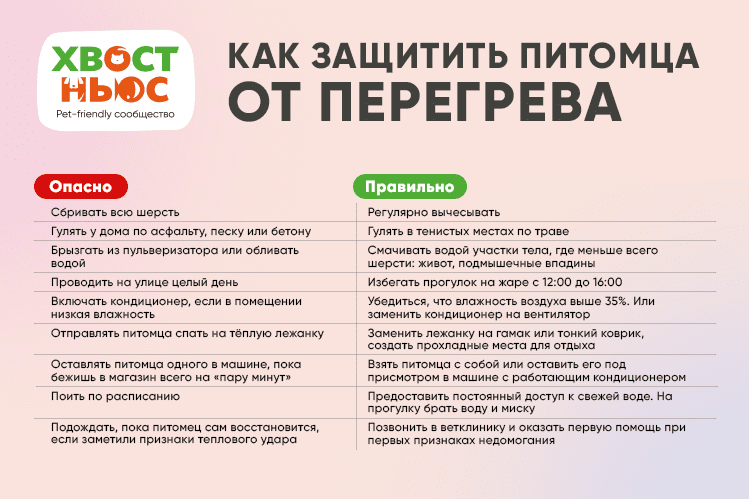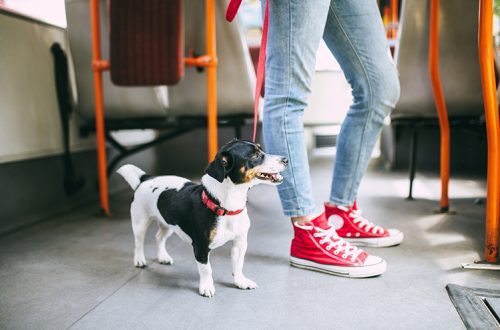
How to help a pet in the heat and what methods are useless. Interview with a veterinarian
Boris Mats, veterinarian at the Sputnik clinic, explains how to help dogs and cats survive the heat.
In the interview, you will find out which popular ways of caring for dogs and cats in the heat work and which are useless. Including – is it okay to water the dog from a spray bottle or cool it under an air conditioner and what are safer and more reliable methods.
How often do you bring pets to your veterinary clinic with heatstroke or overheating?
This problem is especially relevant for the southern regions of Russia. But in Moscow there are such cases. Right now in our clinic the dog is undergoing intensive therapy. Most likely, her condition is just related to heat stroke. There were two such cases last year.
Does breed or age affect how dogs and cats react to heat?
Everything is individual. And yet, puppies, kittens, the elderly, overweight pets and brachycephals have the hardest time: pugs, bulldogs, chihuahuas, boxers, Persian and British cats. Active pets during walks in the sun also overheat faster.
And yet, who has it easier: long-haired or short-haired?
In the short term, longhairs are more comfortable. There is a lot of air between long hairs, and air does not conduct heat well. So cats and dogs with long hair heat up more slowly. Conventionally, at the same air temperature, the Doberman will warm up faster than the Bobtail. But it works the other way too. After overheating, the Doberman will also recover faster.
ТWhen does it make sense to cut or shave a pet so that it is not so hot?
With haircuts, I recommend to be careful – it is better to discuss them with the groomer. But be warned: if you shave your pet and then go out into the sun with him, his skin will not be protected and he may develop a sunburn.
It’s clear. Is it worth it to monitor how much water your pet drinks?
Necessarily. Insufficient fluid intake and dehydration are also dangerous. A low level of fluid in the body can lead to the development of shock: there is less blood in the bloodstream, blood pressure decreases. Heat accelerates dehydration and aggravates the situation. Therefore, in the summer it is especially important to monitor how much your pet drinks.
And yet, how to understand that it is time for a dog or cat to cool off?
Unfortunately, pets have sweat glands only on their paws. “Sweat hail” is not the symptom you should expect from them. But there is another indicator – frequent breathing. To it is added a decrease in physical activity, attempts to hide in the shade or lie down on a cold surface. If you notice these symptoms in your pet – help him cool down!
What does “help cool” mean? What exactly can you do to make your pet feel better?
If the pet is already hot, it needs to be moved to the shade, provide air flow, give water. Take water and a bowl with you when walking your dog. Walk early in the morning or late in the evening when it’s not so hot. Active games are best moderated or replaced with a quiet walk.

And if you just sprinkle your pet with water from a spray bottle or pour water from a bottle – will it help?
I don’t recommend doing that. This is at least inefficient, and as a maximum, the pet will begin to heat up even faster. For a spray or douche to work, water must get on the skin and evaporate from it, cooling the body. But dogs and cats have fur that prevents evaporation. I will explain with examples.
When you spray water on a pet with a spray bottle, it settles on the top layer of the coat and does not reach the skin. At the same time, it reduces the amount of air between the hairs – and the pet begins to take heat faster, that is, it overheats.
If you pour plenty of water on a cat or dog, the pet will really feel better, but not for long. The water will evaporate from the skin and cool it down. But there will be no air between the hairs at all, as a result, the pet will begin to overheat faster. In sum, the effect is not very good.
Instead of a spray bottle and dousing the pet, I recommend moistening the parts of the body with water where there is the least amount of hair. For example, the abdomen and armpits. By evaporating water from the skin, the pet will feel better. At the same time, its main coat will remain dry and continue to protect from overheating.
And what other popular advice about helping in the heat does not work? Or worse, harm pets.
An overheated pet may be advised to move under the air conditioner, but this also does not work. Yes, the air conditioner cools the air, but at the same time it dries it. The mucous membranes dry out, their barrier function is disturbed, and this can lead to the development of respiratory diseases.
Also, untimely maintenance of the filters leads to the accumulation of bacteria in them, which then, together with the air, enter the respiratory tract. That is, dogs and cats should not be kept in an air-conditioned room at all? The risks of harming your pet will be significantly reduced if you change the filters on time and maintain the air humidity in the air-conditioned room at a level above 35-40%.
And what is the most dangerous thing in the heat? What can happen to a pet in a bad scenario?
One of the most dangerous effects of heat is heat stroke. Its reason is simple: the body heats up faster than it can cool down, and the body temperature rises. For some time, the body resists, and when the resources are exhausted, a shock occurs. Failure of all organs develops: intestines, lungs, heart, brain. Blood clotting is disturbed and hemorrhages begin. Mortality in such cases is very high. You may simply not have time to get to the veterinary clinic. Therefore, it is important to try to do everything to prevent heat stroke. The risk of heat stroke is increased by pathologies of the respiratory, cardiovascular and nervous systems.
And how not to confuse heat stroke with another disease – for example, with poisoning?
Analyze symptoms. With heat stroke, body temperature over 40 degrees, rapid breathing, red / pale mucous membranes, increased salivation, incoordination, loss of consciousness, convulsions, tremors, vomiting and diarrhea, rapid heart rate: more than 140 per minute in dogs and more than 220 in cats. These symptoms do not necessarily appear all at once. Even one of them is a signal that you urgently need to see a veterinarian.
Let’s say the symptoms point to heat stroke. What to do, where to run?
You need to go to the vet immediately. Warn the staff in advance so that they are ready to assist you. While calling, move your pet to a cool, shady area. If possible, moisten his body with cool water, create a flow of air: turn on the fan or fan the pet, give him water.
The main thing – do not cool the pet abruptly. Don’t use ice water. This will lead to narrowing of the vessels on the surface of the body and reduce the rate of heat transfer. Body temperature will not be able to normalize.
And the last question – what about holidays? If you are flying to a hot area with a pet, what reaction should you prepare for?
On average, it takes about 60 days to adapt to the heat. If the pet was in a warm climate before the trip, it is less prone to heat stroke. But if you met with the heat for the first time, the risk is much higher. In any case, adaptation does not mean invulnerability. Even after 10 years of safe stay in a hot climate, a pet can develop heat stroke. Therefore, safety precautions must always be observed. Do not be ill!
In order for you to better remember the rules for preventing overheating, I have prepared a visual cheat sheet for you: 





